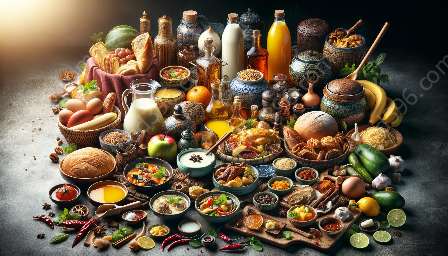When it comes to Australian cuisine, the country's food culture is a vibrant tapestry woven with rich indigenous traditions, diverse regional variations, and a blend of historical influences. In this comprehensive guide, we will delve into the fascinating world of Australian food culture, exploring its regional variations, historical context, and the evolution of culinary traditions.
Australian Food Culture: An Overview
Australian food culture is a reflection of the country’s diverse history, which has influenced its culinary traditions. From the indigenous Aboriginal peoples to waves of migration from Europe and Asia, Australia's food culture is a fusion of cultures, flavors, and techniques.
Key Ingredients and Traditional Dishes
Australian cuisine is characterized by the use of indigenous ingredients such as kangaroo, emu, native fruits, and spices. Traditional Aboriginal dishes like damper, a type of bread, and bush tucker, which includes various wild foods, offer a glimpse into the indigenous food culture.
Regional Variations in Australian Food
Australia's vast and varied landscape has resulted in diverse regional food traditions. In the south, Victoria and Tasmania's cuisine showcases a strong British influence, seen in dishes like meat pies and fish and chips. Meanwhile, the coastal regions of Queensland and New South Wales feature an abundance of seafood, reflecting their proximity to the ocean.
The Influence of Migration on Australian Cuisine
The waves of immigration to Australia have had a profound impact on the country's food culture. Greek, Italian, Chinese, and Vietnamese communities have brought their culinary traditions, ingredients, and flavors, contributing to the vibrant and diverse food scene in Australia.
Culinary Fusion and Modern Australian Cuisine
In recent years, Australian cuisine has been shaped by a renewed focus on native ingredients and a growing interest in culinary fusion. Chefs and food enthusiasts are blending traditional Australian elements with global flavors, creating a modern food culture that is both exciting and innovative.
Food Culture and History
Understanding Australian food culture also requires exploring the historical context of its culinary evolution. The impact of British colonization, the gold rush era, and the multicultural immigration waves have all played a significant role in shaping the country's food traditions and regional variations.
Indigenous Food Culture and Historical Significance
Delving into Australia’s indigenous food culture unveils a deep connection to the land and a historical tradition steeped in sustainability and resourcefulness. Traditional hunting, gathering techniques, and the use of native plants and animals reflect a profound historical significance that continues to influence modern Australian cuisine.
Colonial Influence and Evolution of Australian Cuisine
The arrival of the British colonists in the late 18th century introduced new ingredients, cooking techniques, and culinary customs to the Australian food landscape. This colonial influence laid the foundation for many of the traditional Aussie meals and baking traditions that are still prevalent today.
Modern Adaptations and Culinary Innovations
Australia's food culture has evolved with the changing times, embracing innovation and adaptation. The fusion of international cuisines with indigenous ingredients and cooking methods has led to the emergence of a contemporary Australian food culture that celebrates diversity and creativity.
Exploring Regional Variations in Food Culture
As we explore the regional variations in Australian food culture, it becomes evident that each region's unique geography, climate, and cultural influences have shaped distinct culinary identities.
Tasmania and Victoria: Rich British Tradition
The southern states of Tasmania and Victoria boast a rich British culinary tradition, with a focus on hearty, comforting dishes like meat pies, roast dinners, and traditional English desserts. The cool climate and fertile lands have also contributed to a thriving wine and dairy industry.
Queensland and New South Wales: Coastal Bounty
The coastal regions of Queensland and New South Wales are renowned for their abundance of fresh seafood, tropical fruits, and a vibrant cafe culture. The proximity to the Pacific Ocean has influenced the local cuisine, with a strong emphasis on grilled seafood, fish and chips, and refreshing tropical beverages.
South Australia: Wine and Gourmet Delights
South Australia's Mediterranean-like climate and fertile soil have positioned the region as a hub for wine production and gourmet food experiences. The Barossa Valley and Adelaide Hills are celebrated for their world-class wines, while the food scene showcases a blend of European and indigenous culinary heritage.
Western Australia: Fusion of Flavors
Western Australia's vast coastline and diverse landscapes have fostered a culinary scene that blends indigenous ingredients with Asian and European influences. From fresh seafood to innovative fusion restaurants, the food culture in Western Australia reflects a harmonious convergence of diverse culinary traditions.
Northern Territory: Indigenous Traditions
The Northern Territory's food culture is deeply rooted in indigenous traditions, incorporating native ingredients like crocodile, buffalo, and bush fruits. The region's expansive landscapes and rich cultural heritage offer a unique culinary experience that showcases the historical significance of indigenous food traditions.
The Future of Australian Food Culture
As Australian food culture continues to evolve, there is a growing emphasis on sustainability, indigenous food revival, and culinary innovation. The celebration of regional variations and diverse cultural influences highlights the dynamic nature of Australian cuisine, ensuring its enduring relevance in the global culinary landscape.

